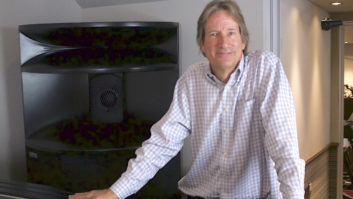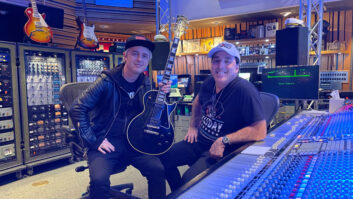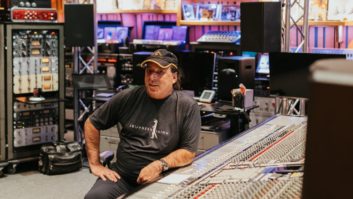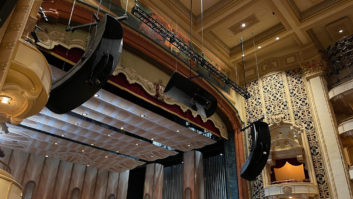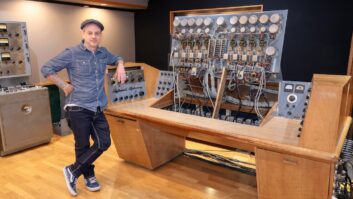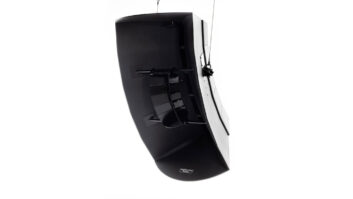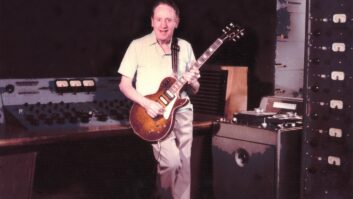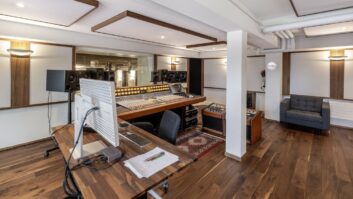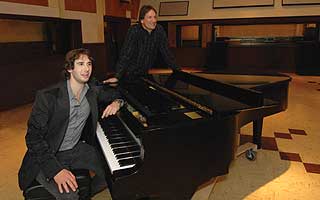
Josh Groban (left, with owner Allen Sides) is currently working on a new album in Ocean Way
with producer Rick Rubin.
Photo: Mr Bonzai
Allen Sides really should write a book; very few people in the music business have had as interesting a career. Most Mix readers probably know highlights of Sides’ resumé: He started in the audio business building custom loudspeakers and doing engineering work in a converted Santa Monica, Calif., garage space; he was taken under the wing of L.A. studio owner/audio guru Bill Putnam; took over Studio B in Putnam’s United Recording facility and renamed it Ocean Way; and later acquired Putnam’s nearby Western Recorders. Sides built Ocean Way into a formidable operation through extensive remodeling, the gradual acquisition of his now-legendary microphone and outboard gear collections, and by attracting top engineers and producers to work there. In the late ’80s, he bought the already successful Record One studios across town; later, he made a foray into Nashville, building an Ocean Way space in an old church. His studios have hosted a dizzying number of top musicians—name ’em and chances are they’ve worked there—and developed long-term relationships with everyone from Quincy Jones to Rick Rubin to Rob Cavallo; the list is staggering. Along the way, he’s also engineered and helped out on countless projects by everyone from Basie to Zappa to Sinatra to Cooder to Clapton to Michael Jackson and dozens of others.
Like Josh Groban, who graces this month’s cover with Sides; the duo are captured in the recently renovated Studio B, which has been restored to its Bill Putnam–era glory and improved with the addition of a spectacular 72-input Neve 8088 console and custom Ocean Way monitoring system. Sides has been working on a new Groban album with producer Rick Rubin.
Sides is up for a Grammy this month for his engineering contributions to Bobby McFerrin’s superb Vocabularies album; more recently, he worked on 13-year-old phenom Greyson Chance’s new album. He has studios outside of L.A., a thriving loudspeaker manufacturing business (Ocean Way Monitor Speakers), a hot rental company (Classic Equipment Rentals), a custom studio setup operation (Ocean Way to Go) and a popular library of drum sounds (Ocean Way Drums); he’s certainly come a long way from that first garage. And for a guy who’s so busy, he’s remarkably calm. We spoke recently about some of the successful tangents that have grown from his L.A. studio base.
I understand that you set up a complete studio in the Hollywood Hills for Radiohead to record their new album. Is that part of your Ocean Way to Go business?
Yes, and Radiohead also did Hail to the Thief in Ocean Way Studio B. Nigel Godrich, their producer, has been a great client.
We’ve been doing this for a long time. The Red Hot Chili Peppers, Linkin Park, we did MGMT—helped them get set up in a house in Malibu. At any given time, we have at least one [outside] studio we’ve set up going somewhere. I did one for Phil Collins: Rob Cavallo and I went to Switzerland and did a record there in a castle. Those projects are a lot of fun and also an interesting technical challenge sometimes.
Tell me a bit about your experiences outside California. You still have Ocean Way Nashville, but it’s being run by Belmont University?
It’s a great studio! I worked on a Faith Hill album there not long ago. It’s a wonderful place and a beautifully run studio, and it’s doing very well. I think the Belmont connection has worked out really great. We have a license agreement with them to maintain the Ocean Way name and the staff and to keep the whole place up to our standards.
How about the more recent acquisition in St. Barth’s in the Caribbean?
Well, St. Barth’s was already a showbiz destination in itself. I mean, here’s an island with some of the best restaurants you’ll ever eat at, fantastic beaches. The studio is in the premier resort in St. Barth’s, which is called Eden Rock, and it’s in a villa on the beach. The couple who own the place and completely redeveloped it, David and Jane Matthews, have been friends of mine for 20 years and are really into music. David specifically built the 16,000-square-foot Villa Rockstar to accommodate my Ocean Way St. Barth’s. It’s a gorgeous studio with a great discrete Neve with Flying Faders and our monitors. Then there’s a theater next door to the control room—“next door” meaning you walk through two glass doors—and it has a stage with musical instruments and everything else. So we can track or record anything there. Also, it’s not just established musical artists who have used the studio, but also some fairly well-off people who maybe want to keep their musician kids entertained—so we can provide a package where we provide producers and engineers to make their songs something special. It’s an interesting group at St. Barth’s.

L-R: Arranger David Campbell, producer and president of Warner Bros. Records Rob Cavallo, and Sides in an orchestral session in Ocean Way Studio B
Photo: Mr. Bonzai

Sides with rock guitarist Steve Vai at the vintage Neve console in Ocean Way’s St. Barth’s studio
Photo: Pia Vai
Do you have plans up the road for other Ocean Ways?
Not at the moment. We have a lot of rooms—six rooms and a mastering room in L.A., and then we have our connection with Ocean Way Nashville and we have Ocean Way St. Barth’s.
Why do you think you’ve thrived when so many other studios have gone under?
Well, it’s hard to say, really. It hurts to see so many friends in the business not succeed. But I’ve always had a concept that you never play on a level playing field. If you can’t do something in a somewhat unique fashion, it’s kind of pointless to be in that business. I like to believe that what we do is a bit different. We really do have some pretty amazing acoustical spaces, and we have very unique equipment that’s very custom, and we have one of the largest collections of esoteric outboard gear anywhere in the world. Beyond that, we’re very sonically driven—we come from a place where sound is the issue. It’s been a business to me, but that’s not the primary thing. It’s always been most about helping people make great-sounding records.
It seems as though the recording studio landscape has drifted toward a few great high-end places like yours and a whole bunch of personal studios that range from funky D.I.Y. places to magnificently equipped facilities owned by popular artists. The middle has gotten squeezed out.
That’s true. The middle end kind of went away.
Have you tried to pick up some of that slack?
A lot of those kinds of projects may come into our place for a day to track or a day to mix or a day to do strings. So we still get that kind of business, but frankly we don’t do as many new artists, who usually have smaller budgets and that has been a little disappointing to me—Greyson Chance being an exception. I guess Lady Gaga wouldn’t be considered a new artist at this point. [Laughs] But we’ve had an incredibly loyal clientele—artists and producers—who keep coming back and filling our rooms so I can’t complain.
But the other thing we’ve done is, about four years ago we started getting involved in a number of outside projects. We spent so many years building a reputation in the business, we said, “Why don’t we make this work for us?” Because, for instance, we always designed and built loudspeakers for clients. I helped Dave Grohl and Rob Cavallo equip their studios, and Trevor Horn’s studio in London. We did Skywalker Ranch; we do a lot of different things like that.
So we decided to try to make an even more commercial product and we got into manufacturing high-end loudspeakers. I think what we’ve created in our HR-2 is pretty unique. What’s different, conceptually, is its dispersional characteristics: It’s 120 degrees and it’s a horn system, but it has a low-frequency and high-frequency horn with identical flair rates, and it’s capable of producing dynamic range that’s fairly staggering. And it’s not harsh; it doesn’t sound like a horn. There’s nothing else like that out there. My exclusive distributor in the United States is GC Pro—Guitar Center—and we’re selling a lot of loudspeakers that way. Then my distributors in Hong Kong and Japan are selling a tremendous amount of systems, so that’s been a very important venture.
Then there’s the Ocean Way drum sample library, which also became a very good product for us. In fact, we have a new library coming out. I just felt we had to get into other areas. We needed to have alternate revenue sources, not just the studios. It’s funny: Some people get jaded in this business, but I feel like I learn new things every time I work, and I still love finding new ways of approaching things.
I know you did some work on the recent posthumous Michael Jackson album (Michael).
That’s right. I recorded the orchestra for and mixed a song called “Gone Too Soon,” which was arranged by David Campbell. And there was this other track called “Behind the Mask,” which was an 8-minute demo that we cut into a 4-minute piece of music, and then it had a number of things added to it.
Michael was one of my best clients. We did part of the work on Thriller. We did drums and strings and various things, and then Quincy and Bruce [Swedien] became some of our best clients and did every album after that. I cannot say enough about Michael as a person; just a wonderful guy and, obviously, a great musician and a fantastic client. He was a delightful guy. I really miss him. I think an incredibly important part of Michael’s success was Bruce Swedien’s masterful creation of a sonic landscape that simply hadn’t been heard before.
Recently, I’ve been working on the Josh Groban record he’s making with Rick Rubin. Rick’s been another great client of ours for years and years, but this was the first time I’ve done a lot of engineering for him. They had recorded a good portion of the album but decided to change a bunch of things. So I ended up re-recording some of the album and then I mixed it.
Rick Rubin and Josh Groban is not a pairing that would’ve come into my mind.
Well, Josh wanted to make a more personal album, and he either wrote or co-wrote most of the songs on it, and Rick really understands song structure and how an emotion hits you. In that way, he’s a little like Rob Cavallo, who’s another guy I work with a lot—in fact, he’s one of my closest allies and a fabulous producer. Rick’s maybe not quite as deliberate in exactly nailing it down as Rob is, but he always knows exactly when it’s on the mark and when it’s not.
Rick wants it super-dry. He handed me a couple of Neil Diamond albums he did and they were so dry it was almost like you were sitting with Neil in his living room with some players around him. With Josh, it’s like he’s in his living room—but so is a 70-piece orchestra! [Laughs] So it’s quite unusual.
